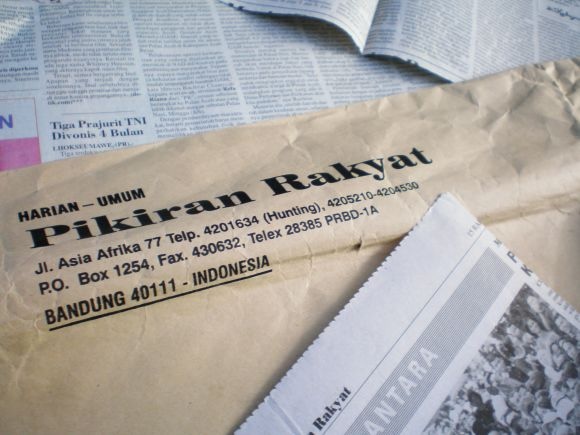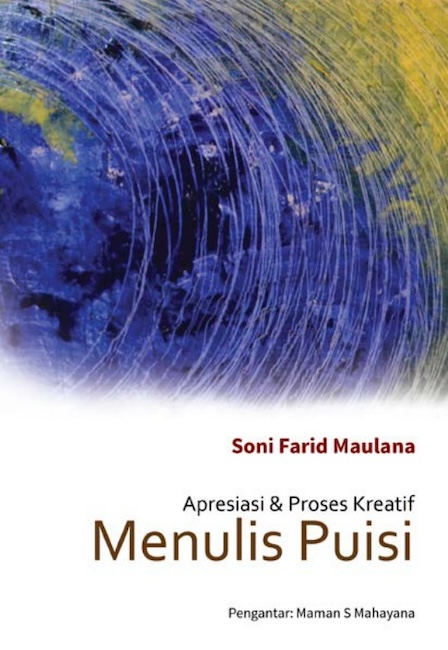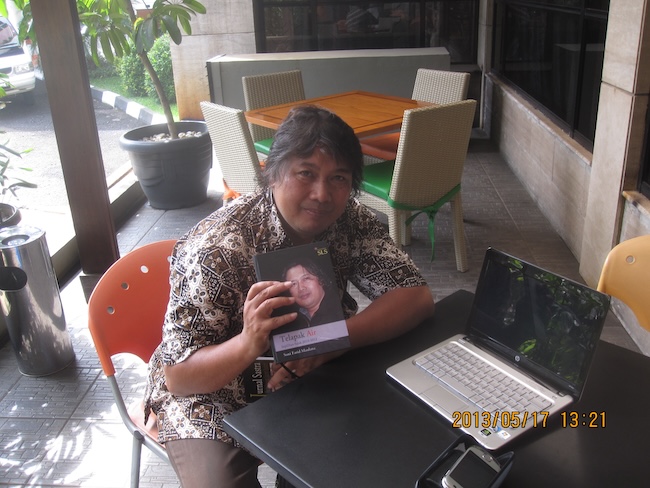Ian Campbell
Soni Farid Maulana, a journalist and poet, was born on 19 February 1962 in Tasikmalaya, West Java, the child of Yuyu Yuhana bin H. Sulaeman and Teti Solihati binti Didi Sukardi. After a long period in which he suffered from complications associated with diabetes, he died in Ciamis, West Java on 27 November 2022.
By 1980, Soni had started sending poems in Indonesian to the ‘Pertemuan Kecil’ segment of Pikiran Rakyat, the main newspaper in Bandung. The segment was edited by academic and poet, Saini K.M., to foster young literary talent in West Java. Soni wrote about his childhood in Tasikmalaya recalling the early influences of certain teachers in fostering an interest in poetry and especially that of his maternal grandmother who had expertise in the Sundanese tembang melodic form of rhymed verse.
In 1982, Soni moved to Bandung to enrol in ASTI (The Academy of Indonesian Arts and Dance, now known as STSI (The Indonesian Arts College), graduating in 1985. Through participation in the networks of artists and writers in Bandung and access to literary publications in print from Jakarta and elsewhere, he also broadened his literary horizons. The late 1980s and early 1990s were particularly important years. He commenced work as a journalist (wartawan) at Pikiran Rakyat in February 1990, although he probably began in-house training in November the previous year. He had also met his future wife, Heni Hendrayani, whom he married on 19 February 1990. They settled in Bandung where they raised three children.
In mid-1996, Soni took on a role helping to establish a cultural section of the paper under the name Khazanah (Treasure Trove), along with Suyatna Anirun (a cultural figure with theatrical expertise) and Aam Amilia (a writer of prose with deep knowledge of Sundanese culture). After Suyatna died, Soni became a senior editor of Khazanah. The segment became a weekly focus for new works, particularly poetry and short stories, as well as notes on cultural matters. It usually had a weekly focus on a particular issue, as well as a section about visual art developments, one for book reviews, a section on language, and brief listings of upcoming cultural events, especially the literary events, in Bandung and surrounding areas.
It was an era when the emphasis on the publication of new poetry and short stories in Indonesian daily press outlets, not just in Jakarta, but in the major provincial cities, was such that the name ‘sastra koran’ was often given to the use of the newspaper as a publication venue. Part of the reason for the phenomenon was the suitability of the poetry and short story formats in newspapers. Another reason was the undoubted role of literature in fostering the greater use of Bahasa Indonesia as a language for (cultural) expression. In the case of Pikiran Rakyat it meant that the paper was well-placed to cover literary developments that were carried out after Suharto left office in 1998.
These were also years when Soni – and others within the arts field in West Java – were in ‘high gear’ bringing to readers articles on literary developments, especially in West Java. There was naturally a concentration on developments in Bandung and its immediate surrounds. There were also particular strengths in coverage of the literary activities in Tasikmalaya, Ciamis and Cirebon, although no locality was neglected, especially when attention was drawn to the role of a particular locality in the life of a prominent writer or cultural figure. Perhaps no staff journalist authored more articles in this regard than Soni Farid Maulana, although his journalist colleague, Ahda Imran, also authored many articles.

Their work was supplemented by non-staff writers who contributed periodically. In the early 2000s these included Acep Zamzam Noor, Nenden Lilis Aisyah, Hawe Setiawan, Cecep Syamsul Hari, Agus R Sarjono, Juniarso Ridwan, Ahmad Syubbanudin Alwy, Godi Suwarna, amongst the many others. High points in the period 2002-2007 included coverage the 2002 Indonesian International Poetry Festival. The first public discussion about the festival in Bandung seems to have been an article by Soni in Pikiran Rakyat (30 January 2002). He acknowledged that much of inspiration for the festival was Rendra’s, as Chair of the Festival. Yet Soni had already argued in his press article ‘Puisi belum dihabisi’, (It’s not an end to poetry) in Pikiran Rakyat (29 November 2001) that poetry had a place in the turmoil that was the world in 2001. However, in 2007 the limits of press freedom for creative writers were tested when a controversy erupted about a poem that had been published in the Khazanah segment of Pikiran Rakyat.
For his own part Soni had written a 2005 press article ‘Sastrawan santri, Adakah Ia’ (Just who is a religious literary writer?). ‘The role of the literary writer or ‘sastrawan’ was ‘first and foremost to produce literary works per se’ was the view he expressed. His poetry was clearly also influenced by his Islamic faith and often allusions are made to Koranic or other religious texts. It also provided a basis in much of his poetry where there are references to personal morality and in the social critiques stated or implied therein.
Different challenges for press publications were emerging at this time. The advantages of digitising had increasingly led to a lessening of focus on direct publication of literary works and in covering the role local associations in promoting such, to giving greater attention to the more visual arts, especially film. The role of social media has also increased in the dissemination of literary works and reliance on the regional newspaper as chronicler of literary developments in regional areas has perhaps lessened.
Poetry
Beyond his press contributions many of Soni’s Indonesian language poems were published in countless anthologies or collections published in Jakarta or elsewhere from 1987 onwards. Poetry collections of his in Indonesian were shortlisted three times in the Khatulistiwa literary awards (2006, 2007 and 2013). He also wrote short stories, a novel, a two-volume book on the development of poetry in modern Indonesia, Selintas Pintas Puisi Indonesia 1 and 2, (A journey through Indonesian Poetry), as well as a host of other literary works that had intersections with both music and theatrical forms. He wrote some poetry in Sundanese: a poem he wrote received a literary award from the Sundanese language and literature cultural organisation (LBSS) in 1999.
He had a reputation in poetry circles, especially in the decade of the early 2000s, of being very productive, even relentless, in his efforts to bring his works in new or collected form into print. He published 22 collections of poems between 1989 and 2015, the majority with Bandung publishers, although his 2005 collection, Secangkir Teh (A cup of tea) was published by Grasindo in Jakarta. His poems consistently found publication in the main newspapers in Jakarta. He read his poetry not just in West Java, but in many of the best-known literary and cultural venues of the capital. In 1999 he had accompanied Rendra and two other poets from West Java, Agus R Sardjono and Nenden Lilis, to the Winternachten Festival in the Netherlands, as well as a literary visit to Paris. The 1999 trip was clearly a highlight in his encounters with the world beyond Indonesia as reflected in the poetry he wrote during and after the trip.

Whilst initially Soni’s poetry was lyrical, infused with his own feelings, he also moved to encompass social themes, especially drawing upon the influence of Rendra’s poems in this vein. By 2004 when his long poem Variasi Parijs van Java (The Paris of Java - a Variation) was published, many of the younger poets in Bandung, had begun to write poems with environmental themes. These poems often focused on aspects of the city environment in and around Bandung itself but sometimes extended their reach to the broader Priangan area, the traditionally Sundanese high country of West Java around Bandung. The general theme was that not only the physical characteristics of the land had been degraded through rampant development and the increase in urbanisation, but the cultural values of community and morality had been set aside.
New poems in this genre also used the theme of the 'environment' as a latter-day critique of aspects of the poem series by Ramadhan K.H. (1927-2006) first published in 1958, titled Priangan Si Jelita (lit. Priangan, the beautiful), which Ramadhan had begun whilst in Spain in the early 1950s. Soni’s long poem, though, by its title, reversed the modernist idea from the 1930s that Bandung was ‘like Paris’ but also referred to the broader Priangan region of West Java. However, not all literary critics could agree that references to the jarring ideas that Industrial pollution of waterways, hillside degradation, bulldozers, loud non-traditional music, drunkenness, and its impacts for loss of ‘self-control’, and prostitution that at times accompanied rapid social changes, were suitable in poetry.
Cecep Syamsul Hari, though, writing in Horison magazine in 2009 suggested that Soni’s long poem, through its anti-romantic deconstruction (of the Ramadhan poem series), was a highpoint in Soni’s poetic achievements. Retrospectively, we can say that the poets from West Java of that era were ‘ahead of their time’ in their treatment of the theme of ‘localism in poetry’ through environmental critique. It is worth noting, though, that whilst much in the early sections, and indeed throughout the Ramadhan poem series speaks to the beauty of the region, in later stages particularly it also alludes to the civil unrest in parts of the region in the early 1950s, and to the need for resilience of the people.
Such has been the power of the short title of Ramadhan’s 1958 poem series that it has often led to the idea that it is solely a poem series in praise of ‘beauty’. Soni had also been critical, albeit retrospectively, of what he saw as Ramadhan’s failure to address the ‘moral decline’ of the current era. His long poem is itself, though, paradoxically, was also a plea for a return to an idealistic ‘sense of place’ that perhaps never fully was. Paris is not always beautiful, for all its residents, all the time. Nevertheless, the whole series of poetic interactions, from the 1950s across the next fifty years or so, are themselves a rich poetic landscape of the people and the highlands of West Java. Indeed, in 2003 Indonesia Tera republished Ramadhan’s poem series, along with translations into English (Harry Aveling), French (Henri Chambert-Loir), German (Berthold Damshauser), with an Indonesian language introduction by Ajip Rosidi.
Many other poems in Soni’s repertoire also draw attention to social issues. There is his much-anthologised 1985 poem, ‘Literatur (sic.) Seorang Buruh Pabrik di Tengah Gemuruh Kota Jakarta’ (The literature of a factory worker in the clamorous city of Jakarta). There are the ‘journalistic’ poems, published in Pikiran Rakyat, such as ‘Inferno’ (sic.), in 2002 after the Bali bombing, which asked, ‘in the name of what religion, why?’. The 2004 poem, ‘Jakarta Luka Bakar’ (Jakarta burning) written after further Jakarta terror attacks, expressed the need for explanations of the ‘why’? Such poems were often written in the immediate aftermath of events, articulating what many ordinary people were perhaps grappling with, at that time.
There are also the poems by Soni, which are experiential, full of the personal, the ‘aku lirik’ in Indonesian, as it has often been named. The 1976 poem ‘Di Pemakaman’ (At the graveside) and the 1977 poem, ‘Tembang’ (sic) speak to the influential figure in his early life, his maternal grandmother, Oneng Rohana, and her mastery of the tembang melodic form of Sundanese rhymed verse. The 1986 poem, ‘Tangis Rahwana’, (Rahwana’s tears’) draws on aspects of the Ramayana story and an episode between two lovers, but with Sundanese allusions in the background. There are also many poems that do have a somewhat melancholic streak. The poem, ‘Si Mati’ (The dead one) is one such which has also been anthologised (2015) in a French-Indonesian language anthology Florilége (ed. Ėtienne Naveau) of poems in the Indonesian sonnet form. Soni’s poems ‘Diluar Mimpi’ (Beyond Dreams) (1997) and ‘Kau’ (You) (2001) are just two other examples in this, often-exquisite verse form, too.
Soni was a poet for whom family, his wife Heni Hendrayani, and his 3 children, were an integral thread in his poetic expression, throughout his adult life. Often joyful, caring, tender poems that were also dedicated to them, or alluded to them. One thinks of the long poem for his wife from the time of his 1999 visit to Paris, ‘Berjalan di Pinggir Sungei Seine’ (Walking along the Seine). There are poems that deal with events in daily life, such as the 1996 poem ‘Dibangunkan hujan’ (What the rain does), about the aftermath inside the family house of a tropical downpour. There is the 1993 poem ‘Angin Malam’ (Night wind), again for his wife. In 2010, a prose poem, for his son, Kautsar, ‘Memburu Capung’ (Catching dragonflies); the world of a child, remembered.
Soni Farid Maulana (1962-2022) will also be remembered as a literary figure from West Java, especially as a poet, who straddled the worlds of press journalism and of Indonesian letters. In each of these fields of craft and endeavour he wrote of the world, and of his world.
Ian Campbell’s publications include Contemporary Indonesian Language Poetry from West Java -National Literature, Regional Manifestations (2008) and Tak ada Peringatan (No Warning) (2013), a collection of his Indonesian language poetry, including nine poems which originally appeared in the Khazanah segment of Pikiran Rakyat from 2003 to 2005.












